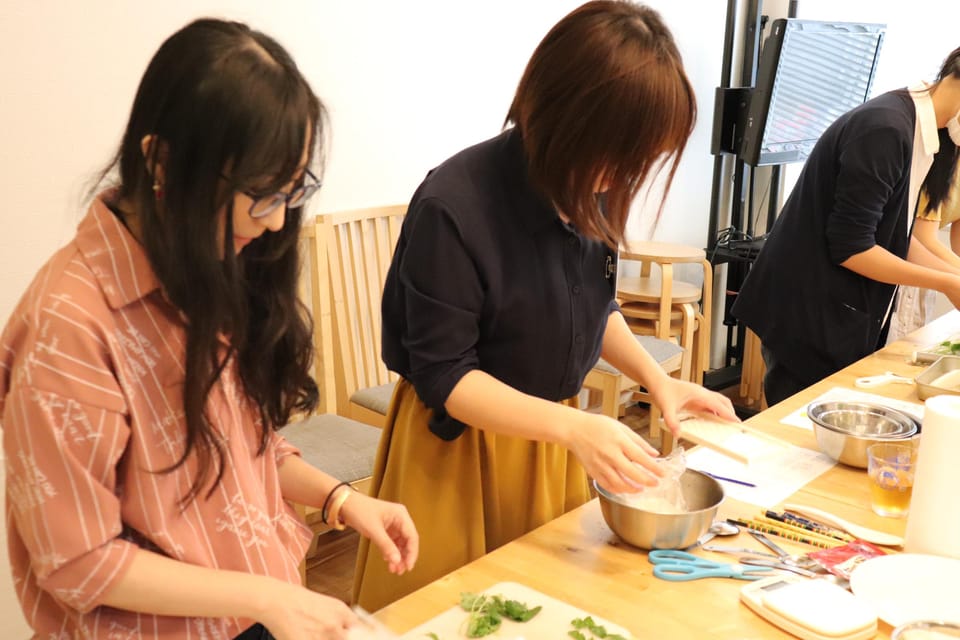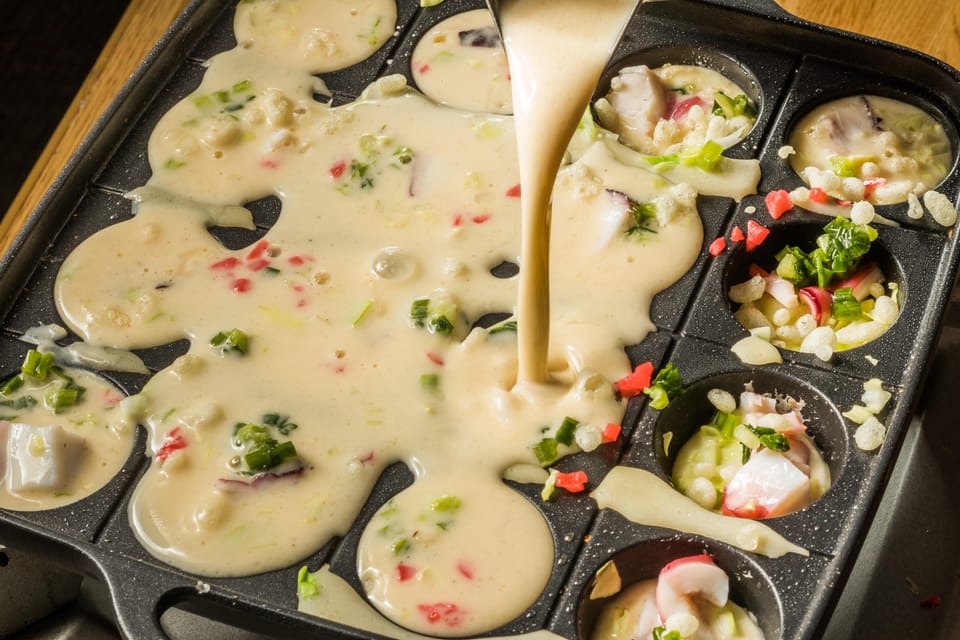Kyoto’s vibrant food scene encompasses a rich tapestry of traditional and innovative culinary delights. One such experience that stands out is the opportunity to explore the world of gluten-free okonomiyaki and takoyaki – two iconic Japanese street foods that captivate the senses. Through a hands-on cooking class, participants can uncover the historical significance and intricate flavors of these beloved dishes, guided by expert instructors in an intimate setting. With personalized attention and high-quality tools, the class promises a memorable journey into Japan’s gastronomic heritage, leaving participants eager to explore further the diverse flavors that Kyoto has to offer.
Key Points
- A 1-hour gluten-free cooking class in Kyoto teaching the preparation of authentic Japanese street foods, okonomiyaki and takoyaki.
- The class is limited to 10 participants and provides personalized instruction, cooking utensils, and a complimentary lunch.
- Participants will learn the historical origins and cultural significance of the dishes, as well as insights from a registered dietitian.
- The class is conveniently located near major transportation hubs in Kyoto, with round-trip transportation included.
- The class accommodates various dietary restrictions and offers flexibility to ensure a safe and enjoyable experience for all participants.
Experience Overview

The gluten-free okonomiyaki and takoyaki cooking class in Kyoto offers participants a unique culinary experience.
Participants learn to prepare these traditional Japanese dishes under the guidance of an expert in Japanese food and preventive medicine. The class lasts for 1 hour and is limited to 10 people, ensuring personalized attention.
Offered in both English and Japanese, the class provides historical context on the origins of these dishes, dating back to the Taisho and Showa eras.
Participants receive aprons, cooking utensils, and a complimentary lunch. The class is conveniently located near several major transportation hubs in Kyoto, making it easily accessible.
Cooking Class Details

During the 1-hour gluten-free okonomiyaki and takoyaki cooking class, participants receive personalized attention from the expert instructor.
The class is limited to just 10 people, ensuring ample hands-on learning opportunities. Participants don professional aprons and use high-quality cooking utensils provided for the session.
As they prepare the traditional Japanese dishes, they’ll gain insights into the cultural and historical context from the registered dietitian.
Detailed English recipes are included, enabling participants to recreate the delicious gluten-free treats at home.
The class also includes round-trip transportation to and from the private kitchen, located just minutes from several major subway stations.
Learning Objectives

Participants in the gluten-free okonomiyaki and takoyaki cooking class gain valuable insights into Japanese food culture and health from the registered dietitian instructor.
The learning experience includes:
- Preparing authentic gluten-free versions of these beloved Japanese street foods, gaining hands-on experience in traditional cooking techniques.
- Understanding the historical origins and cultural significance of okonomiyaki and takoyaki, dating back to the early 20th century.
- Exploring the nutritional benefits and preventive health aspects of these dishes from the perspective of a registered dietitian, who provides guidance on recreating them at home.
The class provides a unique opportunity to explore the intersection of Japanese cuisine, cultural heritage, and holistic wellness.
Historical Context
Okonomiyaki, a savory Japanese pancake, traces its origins back to the Taisho era (1912-1926), when it emerged as a popular street food in Osaka.
Vendors would grill sliced cabbage batter and top it with various fillings, creating a unique and customizable dish.
Takoyaki, on the other hand, originated in the Showa era (1926-1989) as a Kansai specialty.
These spherical snacks are made by pouring a wheat-flour-based batter into special iron molds and filling them with pieces of octopus.
Both dishes have since become beloved icons of Japanese cuisine, reflecting the country’s rich culinary heritage and the ingenuity of its people.
Meeting Point and Directions
The private kitchen where the cooking class is held is conveniently located just a short 5-minute walk from Karasuma Oike Station, which can be accessed via the Subway Kyoto Line and Tozai Line.
For those arriving from other locations, the class venue is also within a 10-minute walk from Karasuma Station on the Hankyu Kyoto Line and Sanjo Station on the Keihan Line.
The straightforward directions make it easy for participants to find the class location:
- From Karasuma Oike Station, head southeast on Karasuma-dori for about 5 minutes.
- Turn left onto a side street and the private kitchen will be on the right.
- The official address is provided upon reservation confirmation.
Dietary Restrictions
Dietary accommodations are readily available for participants with various restrictions.
The cooking class specifically caters to those following gluten-free diets, as evidenced by the gluten-free preparation of the classic Japanese dishes. Participants are encouraged to inform the instructor of any additional dietary needs, such as allergies or intolerances, at the time of reservation.
This allows the experienced instructor to make the necessary adjustments to ensure a safe and enjoyable learning experience for everyone.
The class’s focus on Japanese cuisine and health benefits also makes it suitable for those seeking healthier alternatives or vegetarian/vegan options.
Flexibility and personalization are key aspects of this comprehensive culinary workshop.
Cancellation Policy

As per the article, the cooking class offers free cancellation up to 24 hours in advance for a full refund. This policy provides flexibility for participants and ensures a hassle-free experience.
The key details regarding the cancellation policy are:
- Participants can cancel their reservation up to 24 hours before the scheduled class for a full refund.
- Cancellations made within 24 hours of the class won’t be eligible for a refund.
- The class has a limited group size, so this policy allows for efficient management and ensures availability for other interested participants.
Participant Reviews
Perusing the available reviews, participants seem to have found the gluten-free okonomiyaki and takoyaki cooking class in Kyoto to be a thoroughly engaging and informative experience.
Many praised the expert instructor’s deep knowledge of Japanese food culture and health, providing valuable insights beyond just the cooking techniques.
Learners particularly appreciated the historical context shared about these iconic dishes and the opportunity to recreate them at home using the provided English recipes.
Frequently Asked Questions
Can Participants Take Home the Food They Prepare?
Yes, participants can take home the okonomiyaki and takoyaki they prepare during the class. The cooking experience includes English recipes so participants can recreate the dishes at home after the lesson.
Is the Cooking Class Suitable for Vegetarians or Vegans?
The cooking class is suitable for vegetarians, as the instructor can provide alternative ingredients to accommodate their dietary needs. However, it may not be suitable for vegans, as some traditional takoyaki and okonomiyaki recipes contain animal products.
Are Private Group Bookings Available for the Cooking Class?
Private group bookings are available for this cooking class. The class can accommodate groups of up to 10 participants, allowing for a personalized and intimate experience. Advance reservations are required.
Is the Cooking Class Wheelchair Accessible?
Yes, the cooking class is wheelchair accessible. The private kitchen facility is equipped with wide doorways and ramps, allowing easy access for participants with mobility challenges. The instructor is also able to provide assistance as needed.
Can Participants Take Photos or Videos During the Class?
Participants are generally allowed to take photos and videos during the class, as long as they do not disrupt the learning experience or interfere with the instructor’s demonstrations. The cooking class encourages participants to capture their culinary creations and share the experience.
Recap
This gluten-free cooking class in Kyoto offers a delightful opportunity to explore the iconic Japanese street foods of okonomiyaki and takoyaki. Participants will gain hands-on experience preparing these dishes, while also learning about their historical context and nutritional insights. With personalized instruction and a small group setting, this culinary adventure highlights Japan’s rich food culture in an engaging and memorable way.






